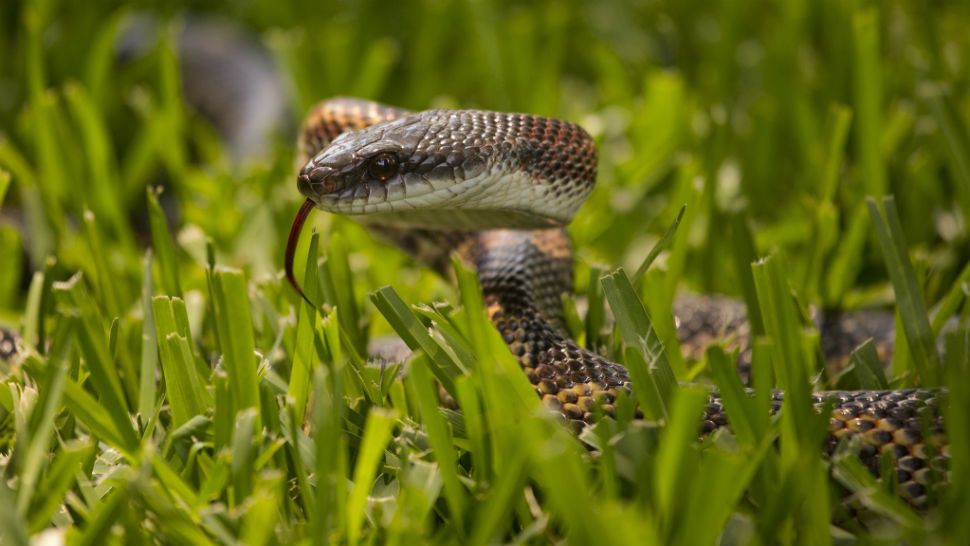COLLEGE STATION, Texas — Texas A&M University experts say spring-like temperatures in areas of Texas mean snakes are coming out of winter hibernation, increasing the likelihood of people and pets getting bit.
A veterinarian with the school's Small Animal Clinical Services, Christine Rutter, says she's already seen cases this year of snakebites on dogs.
Dr. Jill Heatley, an associate professor of veterinary medicine, says snakebite treatment for people can be painful and cost up to $50,000 for venomous cases.
Texas is home to over 105 different species and subspecies of snakes.
The four species of venomous ones:
- Broad Banded Copperhead: Copperhead will mostly eat rodents and belong to the Pit Viper family. This makes them unique in that they have a pit located between the eye and the nostril on either side of the head. These openings house a pair of extremely sensitive infrared detecting organs, which in effect give the snakes a sixth sense that helps them to find and perhaps even judge the size of the small warm-blooded prey. They can look very similar to the Water Moccasin, and are sometimes referred to as the Land Moccasin. In general, you want to be cautious around downed/decaying trees, rock cuts, and sheet metal lying on the ground, trash, rock or wood piles.
- Coral Snake: This snake is not to be confused by the similar colored and non-venomous Milk Snake, whose red and black bands connect. Remember "Red and Yellow kills a fellow, Red and Black is a friend to Jack." Mostly the coral snakes in the eastern part of the state eat snakes and those in western part eat lizards. They tend to be very shy and secretive and will spend most of their time underground, in deep leave litter, dens and burrows. There is no anti-venom being manufactured in the United States that is available for people bitten by this snake. They possess the most potent venom out of any North American snake, but thankfully account for less than one percent of the number of annual snake bites. Respiratory paralysis can occur suddenly or within hours after a coral snake bite, therefore intubation and ventilation should be employed in a victim in anticipation for this.
- Western Diamondback Rattlesnake: Another member of the Pit Viper family, these snakes primarily eat rabbits or other small mammals. You can find them mostly in south Texas and you're likely to hear them before you see them. There are a number of snakes, venomous and non-venomous, that will beat their tail in grass and leaf litter trying to sound like a Rattlesnake. These snakes are a little more aggressive and will rarely back away from confrontation so it is best to always steer clear.
- Cottonmouth (water moccasin): These semi-aquatic Pit Vipers eat fish and frogs. All snakes swim on top of the water, however when they stop to rest or evaluate their surroundings venomous snakes will continue to float on top of the water and non-venomous will sink to where only their head will be visible.
Heatley says only the cottonmouth is considered somewhat aggressive and that most snakes probably are "more afraid of you than you are of them."
She says snakes do help control rodents, lizards and bugs.
What to do if you encounter a venomous snake:
IF YOU SEE THE SNAKE: Stay calm, move slowly away from it and keep your distance. The snake will not attack you.
IF YOU HEAR THE SNAKE BEFORE YOU SEE IT, DO NOT MOVE: Don't move until you see the snake or know exactly where it is. Move slowly away from it, and keep your distance. Again, the snake will not attack you.
If you or someone you know is bitten, from Texas Parks and Wildlife:
- Keep the victim as calm as possible. Keep yourself calm as well.
- Know and treat for any symptoms of shock.
- Wash the bite area with a disinfectant soap.
- Remove restrictive clothing or jewelry in the area of the bite.
- Prevent movement of the bitten extremity.
- Get medical attention as soon as possible.
- Under no circumstances should you cut between the punctures, or suck the venom out or apply electric shock.








